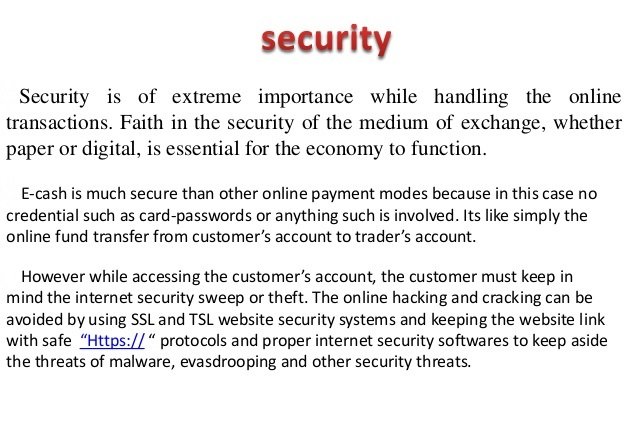The concrete security requirements of electronic payment systems vary, depending both on their features and the trust assumptions placed on their operation. In general, however, electronic payment systems must exhibit integrity, authorization, confidentiality, availability, and reliability.

-
Integrity and authorization
A payment system with integrity allows no money to be taken from a user without explicit authorization by that user. It may also disallow the receipt of payment without explicit consent, to prevent occurrences of things like unsolicited bribery. Authorization constitutes the most important relationship in a payment system. Payment can be authorized in three ways: via out-band authorization, passwords, and signature.
-
Out-band authorization
In this approach, the verifying party (typically a bank) notifies the authorizing party (the payer) of a transaction. The authorizing party is required to approve or deny the payment using a secure, out-band channel (such as via surface mail or the phone). This is the current approach for credit cards involving mail orders and telephone orders: Anyone who knows a user’s credit card data can initiate transactions, and the legitimate user must check the statement and actively complain about unauthorized transactions. If the user does not complain within a certain time (usually 90 days), the transaction is considered “approved” by default.
-
Password authorization
A transaction protected by a password requires that every message from the authorizing party include a cryptographic check value. The check value is computed using a secret known only to the authorizing and verifying parties. This secret can be a personal identification number, a password, or any form of shared secret. In addition, shared secrets that are short like a six-digit PIN are inherently susceptible to various kinds of attacks. They cannot by themselves provide a high degree of security. They should only be used to control access to a physical token like a smart card (or a wallet) that performs the actual authorization using secure cryptographic mechanisms, such as digital signatures.
-
Signature authorization
In this type of transaction, the verifying party requires a digital signature of the authorizing party. Digital signatures provide nonrepudiation of origin: Only the owner of the secret signing key can “sign” messages (whereas everybody who knows the corresponding public verification key can verify the authenticity of signatures.)
-
Confidentiality
Some parties involved may wish confidentiality of transactions. Confidentiality in this context means the restriction of the knowledge about various pieces of information related to a transaction: the identity of payer/payee, purchase content, amount, and so on. Typically, the confidentiality requirement dictates that this information be restricted only to the participants involved. Where anonymity or un-traceability are desired, the requirement may be to limit this knowledge to certain subsets of the participants only, as described later.
-
Availability and reliability
All parties require the ability to make or receive payments whenever necessary. Payment transactions must be atomic: They occur entirely or not at all, but they never hang in an unknown or inconsistent state. No payer would accept a loss of money (not a significant amount, in any case) due to a network or system crash. Availability and reliability presume that the underlying networking services and all software and hardware components are sufficiently dependable. Recovery from crash failures requires some sort of stable storage at all parties and specific resynchronization protocols. These fault tolerance issues are not discussed here, because most payment systems do not address them explicitly.